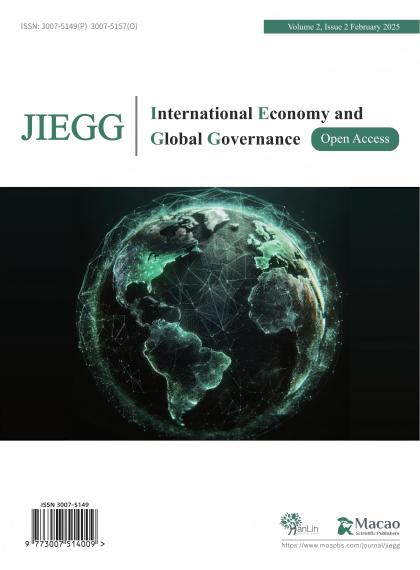-
Li, W. (2023). The future of American hegemony and its order. International Political Research, 44(6), 30-53+5-6.
-
Keohane, R. O. (1984). After Hegemony: Cooperation and Discord in the World Political Economy. Princeton University Press.
-
Kindleberger, C. P. (1973). The World in Depression 1929–1939. University of California Press.
-
Wang, J. S. (2003). The logic of American hegemony. Chinese Journal of American Studies, (3), 7-29+3.
-
Strange, S. (1996). The Retreat of the State: The Diffusion of Power in the World Economy. Cambridge University Press.
-
Organski, A. F. K. (1958). World Politics. Alfred A. Knopf.
-
Gilpin, R. (1981). War and Change in World Politics. Cambridge University Press.
-
Wang, G. X., & Liu, J. H. (2017). The relationship pattern between rising and dominant powers: Prospect theory’s revision of power transition theory. International Forum, 19(5), 58-65+81.
-
Yu, F. and Lu, X. (2022). The Lessons of Banking Reform in China in the Past Century and Its Enlightenment. Hebei Finance, (04): 5-9.
-
You, Q. M. (2018). Power transition theory and its critiques. Forum of World Economics & Politics, (3), 42-61.
-
Xie, T. et al. (2024). The 2024 U.S. election and its global impact. International Forum, (5), 3-41+156.
-
Wallerstein, I. (1984). The Politics of the World-Economy: The States, the Movements, and the Civilizations. Cambridge University Press.
-
Qin, Y. Q.. (2021). Transformation of world order: From hegemony to inclusive multilateralism. Asia-Pacific Security and Ocean Affairs, (2), 1-15+133.
-
Waltz, K. N. (2003). Theory of International Politics (Q. Y. Zhang, Trans.). Shanghai People’s Publishing House. (Original work published 1979)
-
Wang, F. (2023). U.S. hegemonic strategy based on the concept of superiority and its limitations.International Studies, (6), 35-50+1233-1234.
-
Nye, J. S., Jr. (2004). Soft Power: The Means to Success in World Politics. Public Affairs.
-
Wallerstein, I. (2006). The world-system in transition: Wallerstein’s commentaries (D. M. Zhao, Trans.). Social Sciences Academic Press. (Original work published 2004)
-
Wang, J. S. (2003). The logic of American hegemony. Chinese Journal of American Studies, (3), 7-29+3.
-
Nye, J. S., Jr. (2004). Soft Power: The Means to Success in World Politics. Public Affairs.
-
Lu, L. Y., & Bao, J. Z. (2019). From producer to taker: The logic of hegemonic decline.World Economics and Politics, (9), 75-102.
-
Lu, L. Y., & Cui, L. (2024). Hegemonic decline and pan-securitization: An analysis of the US case. Journal of International Security Studies, 42(3), 76-97+159.
-
Friedman, G. (2009). The Next 100 Years: A Forecast for the 21st Century. Doubleday.
-
Ikenberry, G. J. (2011). Liberal Leviathan: The Origins, Crisis, and Transformation of the American World Order. Princeton University Press.
-
Kennedy, P. (1987). The Rise and Fall of the Great Powers: Economic Change and Military Conflict from 1500 to 2000. Random House.
-
Keohane, R. O. (1984). After Hegemony: Cooperation and Discord in the World Political Economy. Princeton University Press.
-
Gilpin, R. (1981). War and Change in World Politics. Cambridge University Press.
-
Kindleberger, C. P. (1973). The World in Depression: 1929–1939. University of California Press.
-
Zhong, F. T. . (2010). Hegemonic Stability Theory and International Political Economy. World Economics and Politics, (4), 109-123.
-
Ikenberry, G. J. (2001). After Victory: Institutions, Strategic Restraint, and the Rebuilding of Order after Major Wars. Princeton University Press.
-
Acharya, A. (2014). The End of American World Order. Polity Press.
-
Baker, P. (2015, March 9). Republicans warn Iran against nuclear deal. The New York Times. https://www.nytimes.com/2015/03/10/world/republicans-warn-iran-against-nuclear-deal.html
-
Pew Research Center. (2023). Global attitudes toward the U.S. Chapter 3.https://www.pewresearch.org/global/chapter-3/
-
European External Action Service. (2019). Statement on the creation of INSTEX. https://eeas.europa.eu/headquarters/headquarters-homepage/58371/

